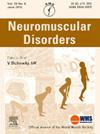Clinical pearls and histopathological features help discriminate toxic rhabdomyolysis from immune-mediated necrotizing myopathy in statin-exposed patients
IF 2.7
4区 医学
Q2 CLINICAL NEUROLOGY
引用次数: 0
Abstract
We have recently noted an increasing number of muscle biopsies performed to quickly rule out anti-HMGCR immune-mediated necrotizing myopathy (IMNM) in statin-treated patients with acute toxic rhabdomyolysis (TR). IMNM is a subacute to chronic progressive auto-immune myopathy diagnosed on clinical phenotype, serology and muscle biopsy, and TR is an acute potentially lethal condition usually diagnosed on clinical phenotype alone. Herein, we aimed to compare these muscle biopsies with a group of IMNM controls. Histopathological analysis of 36 biopsies from statin-exposed TR patients and 29 anti-HMGCR IMNM controls revealed overlapping morphologic patterns in 85 % of cases. Discriminating features highly suggestive of TR included predominance of acute necrotic fibers (p < 0.001), groups of 4+ adjacent necrotic fibers (p < 0.01), regenerative basophilic cuffs (p < 0.001), and lack of LC3+ granular staining in non-necrotic fibers (p < 0.001). Review of clinical data revealed acute creatinine elevation in 94 % TR and none of IMNM controls. Creatine kinase levels (CKs) normalized on average in 12 days (range 8–21) in TR and in >30 days in all IMNM cases. Although pathology can be discriminating, TR should be confirmed by following CKs closely over a few days without immunosuppression and muscle biopsy only performed to confirm IMNM in patients with persistently elevated CKs.
临床特征和组织病理学特征有助于区分他汀类药物暴露患者的中毒性横纹肌溶解和免疫介导的坏死性肌病。
我们最近注意到,在他汀类药物治疗的急性中毒性横纹肌溶解(TR)患者中,越来越多的人进行肌肉活检,以快速排除抗hmgcr免疫介导的坏死性肌病(IMNM)。IMNM是一种亚急性到慢性进行性自身免疫性肌病,通过临床表型、血清学和肌肉活检诊断,而TR是一种急性的潜在致命疾病,通常仅通过临床表型诊断。在此,我们的目的是将这些肌肉活检与一组IMNM对照组进行比较。36例他汀类药物暴露的TR患者和29例抗hmgcr IMNM对照的活检组织病理学分析显示,85%的病例有重叠的形态模式。高度提示TR的鉴别特征包括急性坏死纤维的优势(p < 0.001), 4+相邻坏死纤维的组(p < 0.01),再生嗜碱性袖带(p < 0.001),以及非坏死纤维缺乏LC3+颗粒染色(p < 0.001)。临床资料回顾显示94%的TR患者急性肌酐升高,而IMNM对照组无一例。肌酸激酶水平(ck)在TR患者平均12天(范围8-21天)恢复正常,在所有IMNM病例中,bb0 - 30天恢复正常。尽管病理可能是有区别的,但TR应该通过在没有免疫抑制的情况下密切跟踪ck数天来确诊,并且只有在持续升高的ck患者中进行肌肉活检以确认IMNM。
本文章由计算机程序翻译,如有差异,请以英文原文为准。
求助全文
约1分钟内获得全文
求助全文
来源期刊

Neuromuscular Disorders
医学-临床神经学
CiteScore
4.60
自引率
3.60%
发文量
543
审稿时长
53 days
期刊介绍:
This international, multidisciplinary journal covers all aspects of neuromuscular disorders in childhood and adult life (including the muscular dystrophies, spinal muscular atrophies, hereditary neuropathies, congenital myopathies, myasthenias, myotonic syndromes, metabolic myopathies and inflammatory myopathies).
The Editors welcome original articles from all areas of the field:
• Clinical aspects, such as new clinical entities, case studies of interest, treatment, management and rehabilitation (including biomechanics, orthotic design and surgery).
• Basic scientific studies of relevance to the clinical syndromes, including advances in the fields of molecular biology and genetics.
• Studies of animal models relevant to the human diseases.
The journal is aimed at a wide range of clinicians, pathologists, associated paramedical professionals and clinical and basic scientists with an interest in the study of neuromuscular disorders.
 求助内容:
求助内容: 应助结果提醒方式:
应助结果提醒方式:


